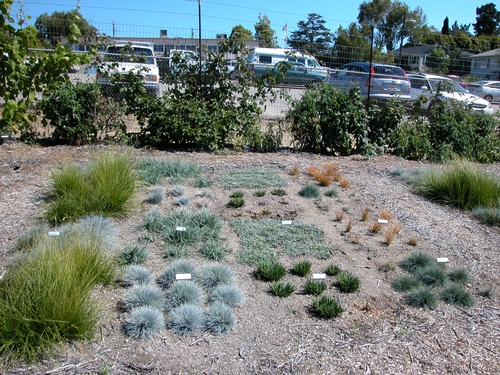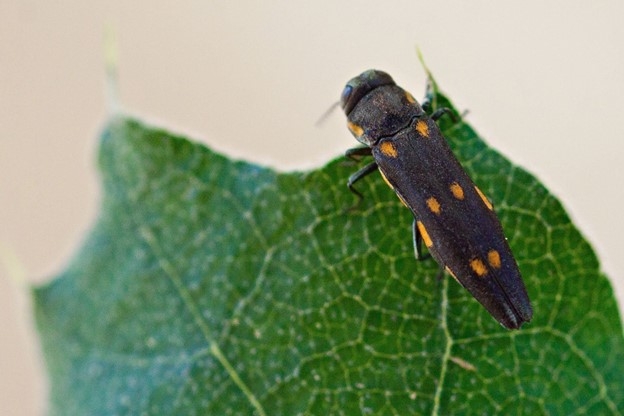- Editor: Jennifer Hopkins
Invasive Spotlight: Goldspotted Oak Borer (GSOB)
Adult goldspotted oak borer, Agrilus auroguttatus, on an oak leaf. Photo by Mike Lewis, Center for Invasive Species Research, Bugwood.org
There are several flatheaded boring beetles in California, however only a few are of particular concern. The goldspotted oak borer (GSOB), Agrilus auroguttatus, is a metallic wood-boring beetle that threatens our native trees. Since it was introduced to Southern California on contaminated firewood in the early 2000s, this pest has caused extensive damage to woodlands and native oaks.
What does the goldspotted oak borer look like?
Adult GSOB are 0.4 inch long and 0.08 inch wide with bullet-shaped bodies. They are black with an iridescent green sheen and six distinct gold spots on their back.
What damage does the goldspotted oak borer cause?
Goldspotted oak borers only attack oaks (Quercus spp.). They are particularly damaging to coast live oak and California black oak. Adult beetles lay eggs on host trees and the larvae bore into the wood, feeding on the tree's vascular tissue. The larvae feed on the tree until they pupate into adults and exit the tree, leaving D-shaped exit holes in the bark. Extensive GSOB feeding can girdle trees, disrupting water and nutrient uptake and eventually causing the tree to die.
What can you do about the goldspotted oak borer?
Don't move firewood! The most important way to prevent the spread of invasive wood borers like GSOB, is to buy firewood where you're going to burn it. If you live in an area of Southern California where GSOB is present, avoid planting susceptible trees. If you need to remove an infested tree, keep the cut wood away from healthy oaks and tarp or grind the wood to kill any larvae present. To report possible sightings, fill out the Goldspotted Oak Borer Symptoms Reporting Form at https://ucanr.edu/sites/gsobinfo/What_You_Can_Do/Report_GSOB_Symptoms/
To learn more about this invasive pest visit the UC IPM Pest Notes: Goldspotted Oak Borer or the UC ANR Goldspotted Oak Borer page.
- Author: Terri Sonleitner Law
- Editor: Noni Todd
Master Gardeners Workshop - Winter Vegetables
By Terri Sonleitner Law UC Master Gardener
Q. What vegetables can I plant in my garden now? Cameron, San Luis Obispo.
A. There are many cool season vegetables you can plant now, which produce well from seeds or from transplants, in the cooler months of the year. Among these vegetables are broccoli, carrots, chard, kale, kohlrabi, leeks, lettuce, spinach, onions and most Asian greens. In San Luis Obispo County, many herbs such as chives, parsley, rosemary and thyme are also hardy year round.
A chart of recommended vegetable planting dates is available through the University of California: http://ucanr.org/sites/gardenweb/files/29040.pdf
If planting and keeping a kitchen garden over the cooler months seems daunting, come to the Master Gardener October “Advice To Grow By” workshop! We’ll feature a talk on kitchen gardens, including how to prepare the garden, grow and enjoy winter vegetables. It will be held in our demonstration garden, the Garden of the Seven Sisters, 2156 Sierra Way, in San Luis Obispo on Saturday, October 20 from 10:00am to noon. Bring a hat, dress for the weather and bring your vegetable and herb gardening questions for our Master Gardener experts.
Q. Every year we’re faced with an invasion of some kind of pest. Once it was mice, and ants are always a problem. What can we do to thwart these pests? Bobbie, Templeton.
A. We have a great resource available! Information on most pests found in California is only a few keystrokes away. The University of California Agricultural & Natural Resources website has a searchable database of research-based information on household pests at the UC IPM Online website: http://www.ipm.ucdavis.edu/PMG/menu.house.html
The Master Gardener’s next “Advice To Grow By” workshop will also feature a timely talk about our most common winter pests, ants and mice, including their habits and effective control methods. Come to the workshop on Saturday, October 20 from 10am to noon, at the Garden of the Seven Sisters, 2156 Sierra Way. Park in the lot adjacent to the garden and bring your timely pest questions for the Master Gardeners.
For more information about Vegetable Gardening, visit The San Luis Obispo UC Master Gardeners Website. You can find the Cool Season Vegetable Planting Guide for SLO County (aka Crop Circle) there!
- Author: Tami Reece
I have caterpillars eating the leaves on my oak trees, what should I do?
Ann M. Arroyo Grande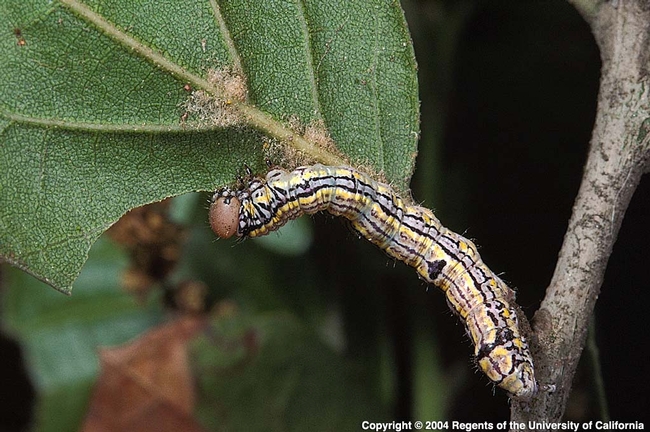
The California oakworm is probably your pest. On a typical year, there may only be two generations of oakworms, but this year was unusually warm and dry in mid-winter, which has created a perfect environment in order to have a third generation. The life cycle of an oak moth starts with eggs, then maturing to a larva (caterpillar), eventually transforming into a chrysalis (pupa) then finally to the adult oak moth. The oakworm is a small light green caterpillar with a dark brown head and dark stripes on their sides. The oak moth may be spotted during the summer afternoons.
The California oakworm’s favorite food of choice is the coast live oak. Populations are unpredictable year to year, with outbreaks appearing occasionally followed by years of almost no damage to oak trees at all. Don't panic, healthy oaks will tolerate extensive loss of leaves without serious harm, so treatment to control oakworms usually is not recommended. In the past month, the Master Gardener helplines have received numerous reports that there is an abundance of oakworms in San Luis Obispo County. Pesticide sprays applied to control oakworms usually are not warranted to protect the health or survival of oak trees. If you believe your oak trees need protection because they are stressed, regularly check foliage for oakworms and spray least toxic pesticides only when caterpillars reach levels needing treatments. Control oakworm and protect oaks with an integrated pest management (IPM) program that relies primarily on the conservation of natural enemies and good cultural practices. Yellowjackets and garden spiders are good predators of oakworms. Providing a birdbath may help increase the amount of birds in your yard, which will help decrease numbers as well. A good resource for identifying and controlling the oakworms through the use of natural enemies is http:www.ipm.ucdavis.edu.
If you feel that your oak tree was weak or dying before the oakworm outbreak, you may want to consider the cultural care of your tree. Oaks do not need irrigation, unless supplementing during a time of winter drought. Is your tree affected by nearby lawns, compacted soil, damaged roots from construction or nearby pavement? UC ANR offers a free download of their publication "Living Among The Oaks" a guide to keeping your oak trees healthy so they can benefit generations to come.
- Posted By: Amy Breschini
- Written by: Maggie King
What jobs should I be doing in my garden in October?
Tish Keely
Santa Margarita
October is one of the most pleasant months in the garden. The temperature is generally mild, the soil is still warm, there are treasures to harvest, and winter rains are, hopefully, on the way.
This is a perfect time for a thorough garden cleanup. Clean out beds regardless of whether you plan to have a winter garden. Dig, divide and replant crowded perennials, cut yellowed asparagus to the ground, remove dead and diseased branches from trees and shrubs and keep ahead of cool season weeds by removing them and mulching the area. Cut back and feed roses after their fall bloom to encourage another bloom before Christmas. Turn and replenish the compost pile using the non-diseased debris from your maintenance.
Take advantage of winter’s anticipated rains by planting native plants and other garden shrubs and sowing wildflower seeds. To guarantee a spectacular spring, sow seeds of sweet peas and other cool season flowers, chill bulbs of tulips, crocuses and hyacinths, and select other fall bulbs for spring color. If you want a winter vegetable garden, this is the time to put in seeds of winter greens and herbs and the many cool season vegetables. Otherwise, consider planting a cover crop to improve your soil.
Many plants will benefit from a good feeding at this time, including fruit trees and turf grass. Acid loving azaleas, camellias and rhododendrons are setting bud now and should be fed.
Pest control continues to be important in October. With the cooler weather, snails and slugs reappear and should be trapped and eradicated.
You will want to reset watering schedules now to reflect the decreased water needs of your garden. Frost sensitive plants suffer less if their watering schedule is controlled to slow their growth at this time of year.
Your garden will reward you for your diligent autumn care by being more productive and attractive in future seasons. As always, the Master Gardeners are available to answer your questions, and their handy The Gardener’s Journal contains a wealth of information about gardening all year round.
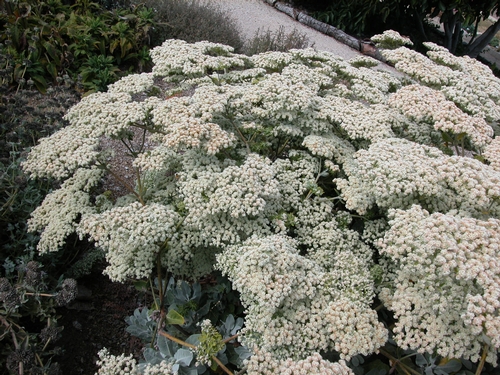
- Posted By: Amy Breschini
- Written by: Ann Dozier
Turf’s up
By Ann Dozier
Q: At the end of summer are you unhappy about the amount of work and water your lawn requires? Or, are you wondering what will fill your vegetable bed when the squash vines are ripped out?
A: No, we’re not recommending that you tear up your lawn and plant vegetables, although that might be a solution for problem lawns. Instead, come to the Master Gardener Advice to Grow by presentation Saturday, September 17, to get some answers to both questions.
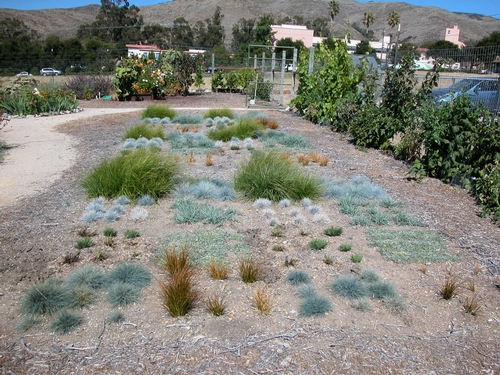
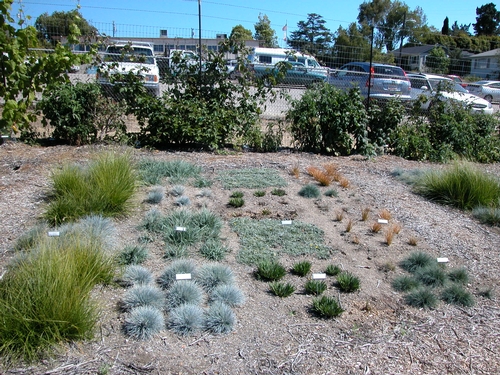
The session will offer a seminar on turf replacement plants featured in the demonstration at the Garden of the Seven Sisters. Gardeners hoping for sustainable ground covers will learn about eight different kinds of ground covers/grasses that take little water or mowing and are disease resistant and amenable to foot traffic. And they look good, too!
The ground covers are planted in 3 different blocks, which will all be on three different irrigation schedules in the future. These grasses may be mowed to resemble lawn or left unmown for easy care. Four of these turf replacements are native to California and four are chosen from other Mediterranean climate areas. All provide attractive alternatives to a conventional lawn. Fall is the best time to plant these new ground covers.
As your vegetable garden winds down summer production you may wonder what vegetables you should plant next – or perhaps you’re planning a season of rest and wonder how to put the vegetable garden to bed for the winter. Another section of Saturday’s presentation will focus on vegetables, showing what winter veggies can be started or planted now. It will also describe the list of chores for fall in the vegetable garden.
The free Advice to Grow By presentations are held from 10-12 at 2156 Sierra Way in San Luis Obispo. Come prepared for changeable weather and bring a chair if possible.
Click here: For more information about the garden turf alternatives.
Got a Gardening Question?
Contact the University of California Cooperative Extension Master Gardeners: at 781-5939 from 1 to 5 p.m. on Monday and Thursday; at 473-7190 from 10 a.m. to noon on Wednesdays in Arroyo Grande; and at 434-4105 from 9 a.m. to noon on Wednesday in Templeton. Visit the UCCE Master Gardeners Web site at groups.ucanr.org/slomg/ or e-mail mgsanluisobispo@ucdavis.edu
